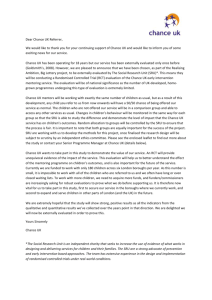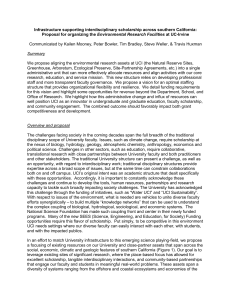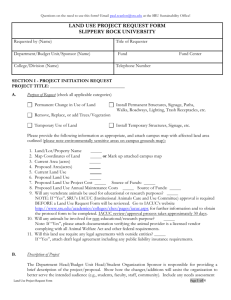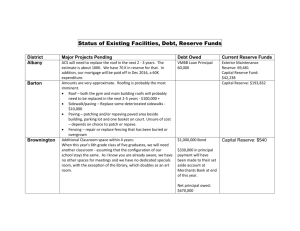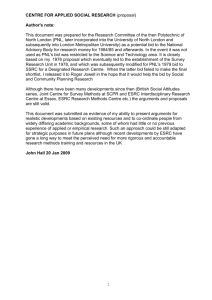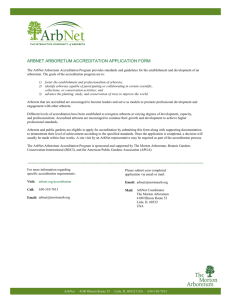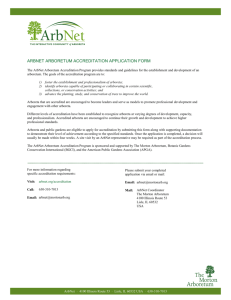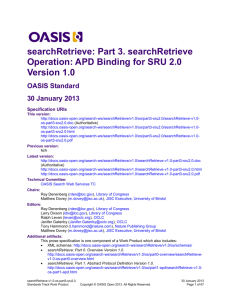synopsis - Sites@UCI
advertisement
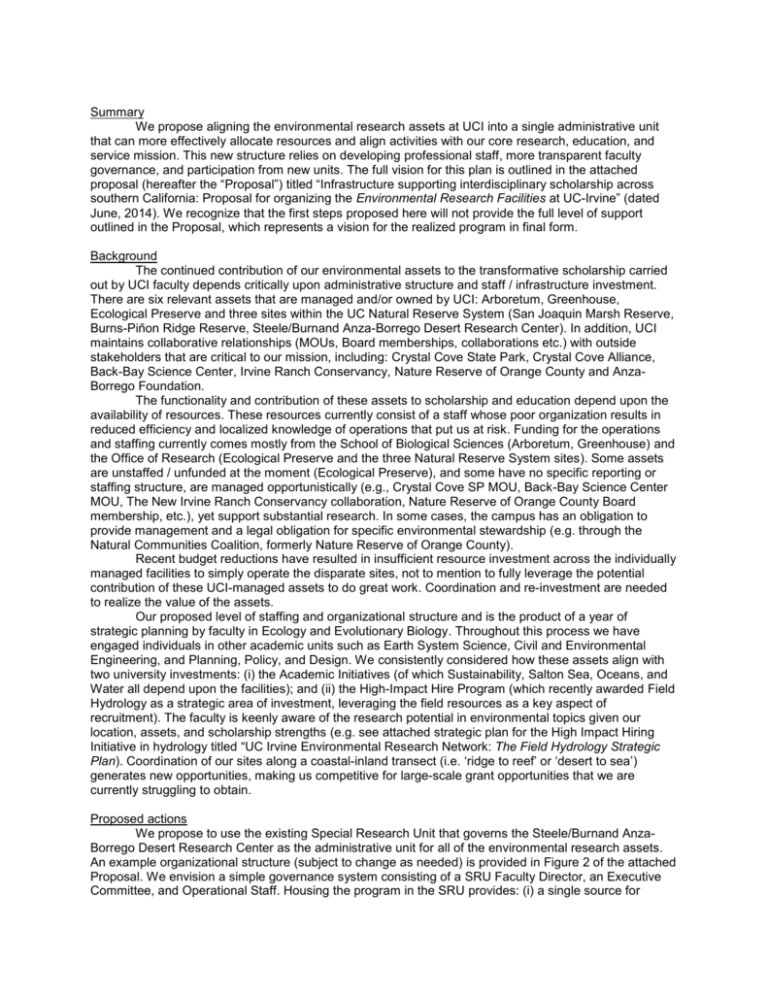
Summary We propose aligning the environmental research assets at UCI into a single administrative unit that can more effectively allocate resources and align activities with our core research, education, and service mission. This new structure relies on developing professional staff, more transparent faculty governance, and participation from new units. The full vision for this plan is outlined in the attached proposal (hereafter the “Proposal”) titled “Infrastructure supporting interdisciplinary scholarship across southern California: Proposal for organizing the Environmental Research Facilities at UC-Irvine” (dated June, 2014). We recognize that the first steps proposed here will not provide the full level of support outlined in the Proposal, which represents a vision for the realized program in final form. Background The continued contribution of our environmental assets to the transformative scholarship carried out by UCI faculty depends critically upon administrative structure and staff / infrastructure investment. There are six relevant assets that are managed and/or owned by UCI: Arboretum, Greenhouse, Ecological Preserve and three sites within the UC Natural Reserve System (San Joaquin Marsh Reserve, Burns-Piñon Ridge Reserve, Steele/Burnand Anza-Borrego Desert Research Center). In addition, UCI maintains collaborative relationships (MOUs, Board memberships, collaborations etc.) with outside stakeholders that are critical to our mission, including: Crystal Cove State Park, Crystal Cove Alliance, Back-Bay Science Center, Irvine Ranch Conservancy, Nature Reserve of Orange County and AnzaBorrego Foundation. The functionality and contribution of these assets to scholarship and education depend upon the availability of resources. These resources currently consist of a staff whose poor organization results in reduced efficiency and localized knowledge of operations that put us at risk. Funding for the operations and staffing currently comes mostly from the School of Biological Sciences (Arboretum, Greenhouse) and the Office of Research (Ecological Preserve and the three Natural Reserve System sites). Some assets are unstaffed / unfunded at the moment (Ecological Preserve), and some have no specific reporting or staffing structure, are managed opportunistically (e.g., Crystal Cove SP MOU, Back-Bay Science Center MOU, The New Irvine Ranch Conservancy collaboration, Nature Reserve of Orange County Board membership, etc.), yet support substantial research. In some cases, the campus has an obligation to provide management and a legal obligation for specific environmental stewardship (e.g. through the Natural Communities Coalition, formerly Nature Reserve of Orange County). Recent budget reductions have resulted in insufficient resource investment across the individually managed facilities to simply operate the disparate sites, not to mention to fully leverage the potential contribution of these UCI-managed assets to do great work. Coordination and re-investment are needed to realize the value of the assets. Our proposed level of staffing and organizational structure and is the product of a year of strategic planning by faculty in Ecology and Evolutionary Biology. Throughout this process we have engaged individuals in other academic units such as Earth System Science, Civil and Environmental Engineering, and Planning, Policy, and Design. We consistently considered how these assets align with two university investments: (i) the Academic Initiatives (of which Sustainability, Salton Sea, Oceans, and Water all depend upon the facilities); and (ii) the High-Impact Hire Program (which recently awarded Field Hydrology as a strategic area of investment, leveraging the field resources as a key aspect of recruitment). The faculty is keenly aware of the research potential in environmental topics given our location, assets, and scholarship strengths (e.g. see attached strategic plan for the High Impact Hiring Initiative in hydrology titled “UC Irvine Environmental Research Network: The Field Hydrology Strategic Plan). Coordination of our sites along a coastal-inland transect (i.e. ‘ridge to reef’ or ‘desert to sea’) generates new opportunities, making us competitive for large-scale grant opportunities that we are currently struggling to obtain. Proposed actions We propose to use the existing Special Research Unit that governs the Steele/Burnand AnzaBorrego Desert Research Center as the administrative unit for all of the environmental research assets. An example organizational structure (subject to change as needed) is provided in Figure 2 of the attached Proposal. We envision a simple governance system consisting of a SRU Faculty Director, an Executive Committee, and Operational Staff. Housing the program in the SRU provides: (i) a single source for decision-making (the SRU Faculty Director, appointed by, and reporting to the Vice-Chancellor for Research, in consultation with Deans); (ii) a single place to decide on representation on the Executive Committee (the SRU Director will make appointments to the Executive Committee based on recommendations from Department Chairs, Deans, and Center Directors for representation of programs and site-specific faculty advisors); (iii) the potential for more coordinated fund-raising and program-level investment (through the establishment of an External Advisory Board to assist with development and single-campus proposals to UCOP opportunities for additional funding); and (iv) a single interface for campus administrators and community stake holders relative to issues associated with these assets. This single line-of-command will be informed in part by the Executive Committee representing the different environmental assets (e.g., Arboretum, Ecological Preserve, Greenhouse, NRS sites), programs (e.g., outreach and education) and stakeholders from across campus (e.g Earth System Science, Civil and Environmental Engineering, and Planning, Policy, and Design), yet a single individual faculty will remain responsible to the administration. A member of this Executive Committee will be appointed by the UCOP to represent UCI on the Natural Reserve System Advisory Committee (this individual would strategically be different than the SRU Faculty Director). In short, this single reporting structure allows for the flexible application of staff across assets and, in so doing, coordinates strategic investment and the use of limited funds to maximally benefit a broad range of faculty, academic units and the mission of supporting research, education and service. We propose the following first steps to begin the process of implementing the structural reorganization: (1) Assignment of the proposed governance structure, consisting of: (i) Appointment of Special Research Unit Director; (ii) re-alignment of existing NRS and Greenhouse staff to report to the SRU Director; and (iii) assignment of responsibility for Burns-Piñon Ridge Reserve to staff at Steele/Burnand Anza-Borrego Desert Research Center. (2) Increased staffing, consisting of: (i) Hiring of a technician to work jointly across the Arboretum, the UCNRS San Joaquin Marsh Reserve and the Ecological Preserve; (ii) hiring of a Director of Environmental Research Facilities (a PhD-level position) to oversee all operational staff and report to the SRU Director; and (iii) continuation of the temporary employees currently at those assets (two 40% hourly technicians). (3) Defining of operational budget by OR and Biological Sciences, including the provision of faculty stipends where deemed appropriate. In addition, we propose specific infrastructure investment at the Arboretum based upon critical inadequacies that present otherwise insurmountable barriers to near-term research goals: (4) Infrastructure investment at the Arboretum to increase research capacity, consisting of: (i) Replacement of entrance gate to provide easy access and security; (ii) removal of failing shade-houses; and (iii) construction of experimental “common garden” facility (soil movement and amendment, irrigation, fencing, etc.).
